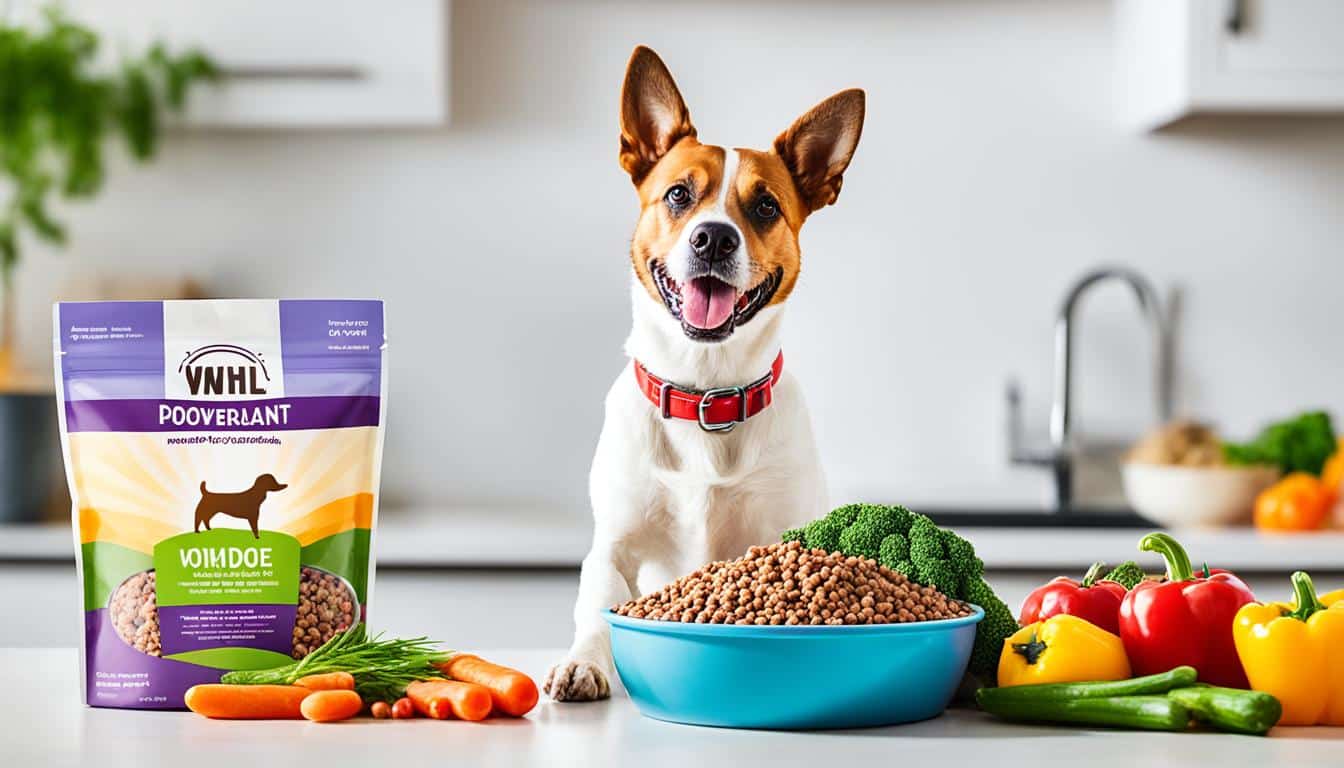Wholesome Creations: Homemade Dog Food Recipes For Happy, Healthy Pups
Welcome to “Wholesome Creations: Homemade Dog Food Recipes for Happy, Healthy Pups.” As pet owners, we all want the best for our furry friends, and one of the most important aspects of their well-being is their diet. Providing homemade dog food recipes is a wonderful way to ensure that your canine companions enjoy nutritious and delicious meals that contribute to their overall health and happiness.
Why settle for commercial dog food that often contains processed ingredients and lacks the freshness and natural goodness your dog deserves? With homemade dog food recipes, you have the power to select high-quality ingredients, prepare meals to suit your dog’s individual needs, and add the personal touch of love and care that makes all the difference.
Whether you choose to cook your dog’s meals or provide raw options, homemade food allows you to have control over what goes into your pup’s bowl. You can avoid artificial additives, fillers, and preservatives that are commonly found in commercial dog food, and instead focus on providing a balanced and wholesome diet tailored to your dog’s specific nutritional requirements.
In this article, we will explore the benefits of homemade dog food, discuss essential ingredients for homemade meals, provide tips on balancing your dog’s nutritional needs, and share homemade dog food recipes for various dietary requirements. We will also guide you on how to safely prepare, store, and serve homemade meals, ensuring that your pup’s meals are always fresh and delicious.
So, let’s embark on this exciting journey of culinary delights for your furry friend! Get ready to discover tasty, nutritious, and easy-to-make recipes that will have your dog wagging their tail in delight.
Key Takeaways:
- Homemade dog food recipes offer numerous benefits for your furry friend’s health and happiness.
- By opting for homemade food, you can provide fresh, natural ingredients without artificial additives or preservatives.
- Homemade dog food allows you to cater to your dog’s individual nutritional needs and preferences.
- You have the flexibility to cook or provide raw options, ensuring a balanced and wholesome diet.
- Preparing homemade dog food shows your love and care, making mealtime an enjoyable experience for your pup.
Why Choose Homemade Dog Food?
When it comes to nourishing our furry companions, we all want the best for them. That’s why many pet owners are turning to homemade dog food as a healthier alternative to commercial options. In this section, we will explore the drawbacks of commercial dog food and highlight the benefits of a homemade diet.
The Drawbacks of Commercial Dog Food
Commercial dog food often contains processed ingredients that may not provide the necessary nutrients for our dogs’ optimal health. Many commercial brands use fillers, additives, and preservatives to extend shelf life, which can be harmful in the long run. These processed foods may lack the natural goodness that our dogs need to thrive.
Furthermore, some dogs may have specific dietary requirements or sensitivities that commercial dog food cannot address. This is where a homemade diet offers a unique advantage, as it allows pet owners to tailor their dog’s meals to meet their individual needs.
The Benefits of a Homemade Diet
Opting for a homemade diet gives you full control over what goes into your dog’s food bowl. By using fresh, natural ingredients, you can ensure that your dog’s meals are nutritious and free from harmful additives. Homemade dog food allows you to provide a balanced and wholesome diet that supports your dog’s overall well-being.
“Preparing homemade dog food allows pet owners to have peace of mind knowing exactly what their dogs are eating. It’s a loving and responsible way to care for our four-legged family members.”
Furthermore, homemade dog food can offer various health benefits. Natural ingredients can support your dog’s digestive health, promote a shiny coat, and boost their immune system. It can also help manage weight, prevent allergies, and provide the necessary energy for an active lifestyle.
A homemade diet is especially beneficial for dogs with specific health conditions or sensitivities. By preparing meals tailored to their needs, you can provide targeted nutrition that may help alleviate symptoms and improve their overall quality of life.
When choosing natural dog food, be sure to consult with your veterinarian or a canine nutritionist to ensure your dog receives a well-balanced diet that meets their specific nutritional requirements.
The Importance of Fresh, Natural Ingredients
A key advantage of homemade dog food is the use of fresh, natural ingredients. These ingredients are rich in essential nutrients and are not degraded by processing methods like commercial dog food. They provide important vitamins, minerals, and antioxidants that promote optimal health and longevity in our pets.
When preparing homemade dog food, prioritize lean proteins like chicken, turkey, or beef, as well as a variety of vegetables and whole grains. Avoid ingredients that are toxic to dogs, such as onions, grapes, raisins, and chocolate.
By feeding our beloved dogs natural, homemade meals, we nourish their bodies and show them the love and care they deserve.
Essential Ingredients for Homemade Dog Food
When it comes to preparing nutritious and delicious homemade dog food, selecting the right ingredients is crucial. By incorporating wholesome and natural ingredients, you can ensure that your furry friend gets the essential nutrients they need for optimal health. In this section, we will explore some key ingredients that are essential for homemade dog food recipes.
Lean Proteins: Ground Turkey
One of the foundations of a balanced homemade dog food recipe is a lean source of protein. Ground turkey is a popular choice among dog owners due to its high protein content and low fat content. It provides essential amino acids that support muscle growth, repair, and overall canine health. Additionally, ground turkey is relatively easy to digest, making it suitable for dogs with sensitive stomachs.
Nutrient-Rich Options: Beef Liver
Another vital ingredient for homemade dog food is nutrient-rich organ meat. Beef liver is an excellent choice that offers a wide range of essential vitamins and minerals. It is rich in vitamins A, B, and K, as well as iron, copper, and zinc. These nutrients contribute to a healthy immune system, promote optimal organ function, and support overall vitality. When incorporating beef liver into your dog’s diet, it is important to ensure that it is cooked thoroughly to eliminate any potential health risks.
Homemade Beef Bone Broth: A Nourishing Addition
Homemade beef bone broth is a nutritious and flavorful addition to your dog’s homemade meals. It is made by simmering beef bones in water for an extended period, allowing the bones to release their beneficial nutrients. Beef bone broth is rich in collagen, amino acids, and various minerals, such as calcium and phosphorus. These nutrients support joint health, aid digestion, and contribute to a shiny coat. Incorporating homemade beef bone broth into your dog’s meals can help keep them hydrated and provide additional flavor and nourishment.
Balancing Nutritional Needs
When it comes to preparing homemade meals for your beloved pup, it’s important to consider their dog needs for optimal dog nutrition. Providing balanced and nutritious meals is key to keeping your dog healthy and happy.
Good nutrition is the foundation of wellness for dogs. A well-balanced diet supports their overall health, enhances their immune system, and contributes to their longevity. By understanding the nutritional requirements of your dog, you can ensure that their meals are tailored to meet their specific needs.
One of the essential aspects of balancing nutritional needs is including a variety of ingredients that offer different nutrients. Dogs require a combination of proteins, carbohydrates, fats, vitamins, and minerals in their diet. Each nutrient plays a vital role in their overall well-being and should be included in appropriate amounts.
Dog needs a sufficient amount of protein to support muscle growth, repair tissues, and maintain healthy skin and coat. Lean sources of protein such as chicken, beef, or fish can be included in homemade meals. It’s important to ensure that the protein source is of high quality and free from bones, skin, and excess fats.
Carbohydrates are another essential component of a dog’s diet. They provide energy and aid in digestion. Opt for whole grains like brown rice or quinoa, and include a variety of vegetables such as carrots, peas, and sweet potatoes. These carbohydrates offer essential vitamins, minerals, and fiber that dogs need to maintain a healthy digestive system.
“A well-balanced diet supports their overall health, enhances their immune system, and contributes to their longevity.”
Fats are necessary for the absorption of certain vitamins and provide energy for dogs. Including healthy sources of fats such as salmon oil or flaxseed oil in your dog’s meals can promote a healthy coat and skin, as well as support brain function.
To ensure your dog receives all the necessary vitamins and minerals, consider incorporating a variety of fruits and vegetables into their meals. Fruits like blueberries and apples offer antioxidants, while vegetables like spinach and broccoli provide essential vitamins and minerals.
Finally, it’s important to monitor portion sizes to prevent overfeeding or underfeeding. The appropriate amount of food varies based on your dog’s age, size, activity level, and overall health. Consult your veterinarian to determine the ideal portion sizes for your furry friend.
Sample Nutritional Balance for Homemade Dog Meals
| Ingredient | Benefits |
|---|---|
| Lean Protein (e.g., chicken, beef, or fish) | Supports muscle growth, repair tissues, and maintains healthy skin and coat |
| Whole Grains (e.g., brown rice or quinoa) | Provides energy and aids in digestion |
| Vegetables (e.g., carrots, peas, sweet potatoes) | Offers essential vitamins, minerals, and fiber |
| Fats (e.g., salmon oil or flaxseed oil) | Aids vitamin absorption, promotes a healthy coat and skin, and supports brain function |
| Fruits (e.g., blueberries or apples) | Provides antioxidants |
| Leafy Greens (e.g., spinach or broccoli) | Offers essential vitamins and minerals |
By carefully selecting and balancing these ingredients, you can create homemade meals that are good for your dog and address their nutritional needs. Regularly monitoring their weight, energy levels, and overall health will help you ensure that your pup is receiving the necessary nutrients.
Remember, it’s always best to consult with your veterinarian before making any significant changes to your dog’s diet. They can provide valuable guidance and advice based on your dog’s unique needs and health condition. With a balanced and nutritious homemade diet, you can keep your dog healthy and thriving for years to come.
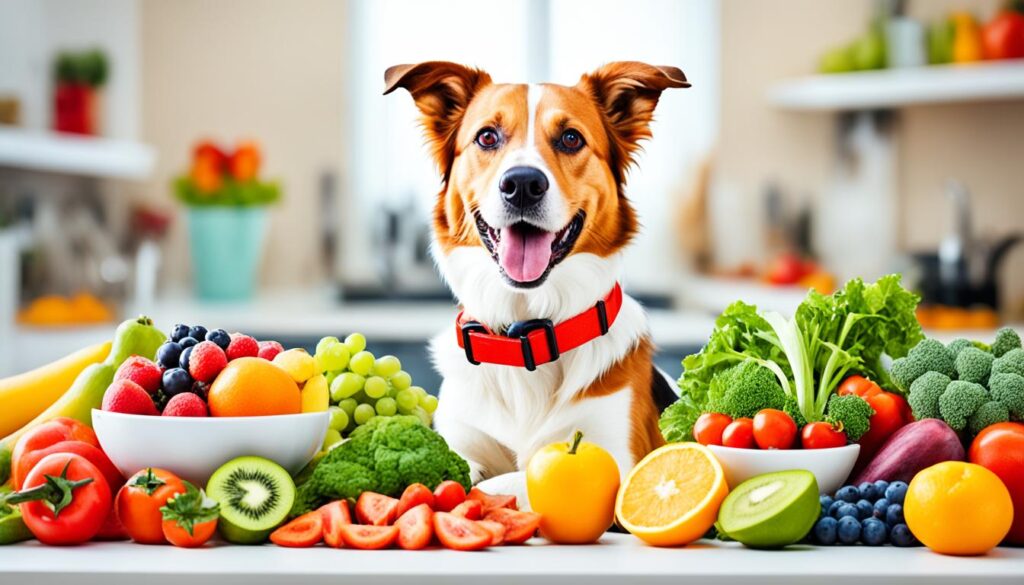
Making Homemade Dog Food
When it comes to preparing homemade dog food, there are various methods and techniques to consider. Whether you choose to use a food processor for cooked meals or explore raw food options, the goal is to provide your furry friend with wholesome and nutritious meals that promote their overall health and well-being.
Cooked Dog Food
If you prefer to cook your dog’s meals, using a food processor can be a great tool to ensure that the ingredients are finely chopped and mixed together. This can help with digestion and make it easier for your dog to enjoy their food.
Here’s a simple recipe for cooked homemade dog food:
| Ingredients | Amount |
|---|---|
| Lean ground turkey | 1 pound |
| Carrots, chopped | 1 cup |
| Sweet potatoes, peeled and cubed | 1 cup |
| Brown rice, cooked | 1 cup |
| Olive oil | 1 tablespoon |
Instructions:
- In a large pot, cook the ground turkey until browned.
- Add the chopped carrots, sweet potatoes, cooked brown rice, and olive oil to the pot.
- Cover the pot and let the ingredients simmer until the vegetables are tender.
- Allow the mixture to cool before serving it to your dog.
Raw Dog Food
Raw dog food, also known as a raw diet, involves feeding your dog uncooked ingredients that mimic what they might eat in the wild. If you choose this option, it’s important to ensure that the ingredients are safe and nutritionally balanced.
While making a raw dog food diet requires careful planning and consideration, many dog owners believe that it provides numerous health benefits. If you’re interested in feeding your dog a raw diet, consult with your veterinarian to create a balanced meal plan that meets your dog’s specific nutritional needs.
Homemade Dog Treats
In addition to their regular meals, homemade dog treats are a great way to show your furry friend some extra love. By using simple, dog-friendly ingredients, you can create tasty and wholesome treats that your dog will enjoy.
Here’s a recipe for delicious homemade dog treats:
| Ingredients | Amount |
|---|---|
| Whole wheat flour | 2 cups |
| Peanut butter, unsalted | 1/2 cup |
| Water | 1/2 cup |
| Applesauce, unsweetened | 1/4 cup |
Instructions:
- Preheat your oven to 350°F (175°C) and line a baking sheet with parchment paper.
- In a mixing bowl, combine the whole wheat flour, peanut butter, water, and applesauce. Mix until a dough forms.
- Roll out the dough on a lightly floured surface to your desired thickness.
- Use cookie cutters to cut out shapes from the dough and place them on the prepared baking sheet.
- Bake in the preheated oven for 15-20 minutes or until the treats are golden brown.
- Allow the treats to cool completely before serving them to your dog.
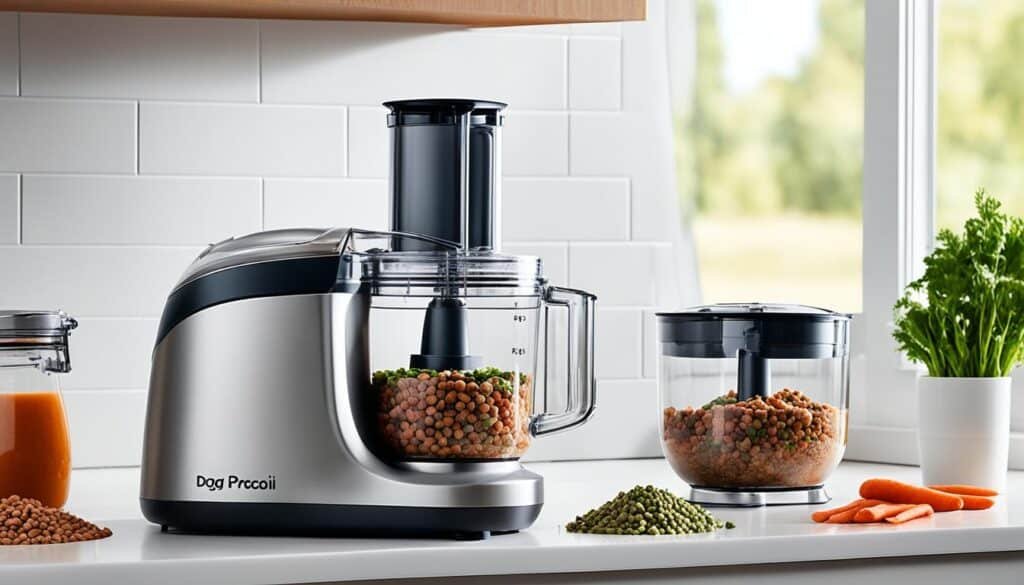
By incorporating a variety of preparation methods and techniques, you can provide your dog with a well-rounded and flavorful homemade diet. Whether you choose to use a food processor for cooked meals, explore the benefits of a raw food diet, or whip up delicious homemade dog treats, your pup is sure to appreciate the love and care that goes into each homemade meal.
Homemade Dog Food Recipes for Specific Needs
When it comes to catering to your dog’s nutritional needs, one size does not fit all. Just like humans, dogs have specific dietary requirements that can vary depending on their age, health conditions, and individual preferences. In this section, we will provide you with homemade dog food recipes tailored to address specific needs such as dogs with kidney issues, senior dogs, and picky eaters.
Recipes for Dogs with Kidney Issues
For dogs with kidney issues, it is crucial to provide them with a diet that supports their kidney health while still meeting their nutritional requirements. One recipe that is gentle on the kidneys yet packed with essential nutrients is the Chicken and Sweet Potato Stew. This recipe combines lean chicken, which is a great source of protein, with sweet potatoes that are low in phosphorus, making it suitable for dogs with kidney problems. To view the recipe, click on the link below:
Another option for dogs with kidney issues is the Turkey and Rice Casserole. This recipe utilizes ground turkey, which is a lean protein source, and white rice, which is easy to digest. Both ingredients are low in phosphorus, making it an ideal choice for dogs with compromised kidney function. To view the recipe, click on the link below:
Recipes for Senior Dogs
As dogs age, their nutritional needs change, and they may require certain ingredients to support their overall health and well-being. One recipe specifically designed for senior dogs is the Salmon and Quinoa Medley. Salmon is rich in omega-3 fatty acids, which promote healthy brain function and reduce inflammation. Quinoa is a nutritious grain that provides essential vitamins and minerals, making it an excellent choice for senior dogs. To view the recipe, click on the link below:
Another recipe suitable for senior dogs is the Beef and Barley Stew. This recipe combines tender beef, which is a great source of high-quality protein, with barley, a grain that aids in digestion and provides energy. To view the recipe, click on the link below:
Recipes for Picky Eaters
We all know how challenging it can be to please a picky eater, especially when it comes to our furry friends. Luckily, there are homemade dog food recipes that are both nutritious and appealing to even the most discerning palates. One recipe that picky eaters are sure to love is the Chicken and Vegetable Stir-Fry. This recipe combines flavorful chicken with a variety of colorful vegetables, providing a balanced and tasty meal. To view the recipe, click on the link below:
Another recipe that will entice picky eaters is the Beef and Pumpkin Meatballs. The savory beef combined with the mild sweetness of pumpkin is a winning combination that even the fussiest dogs will enjoy. To view the recipe, click on the link below:
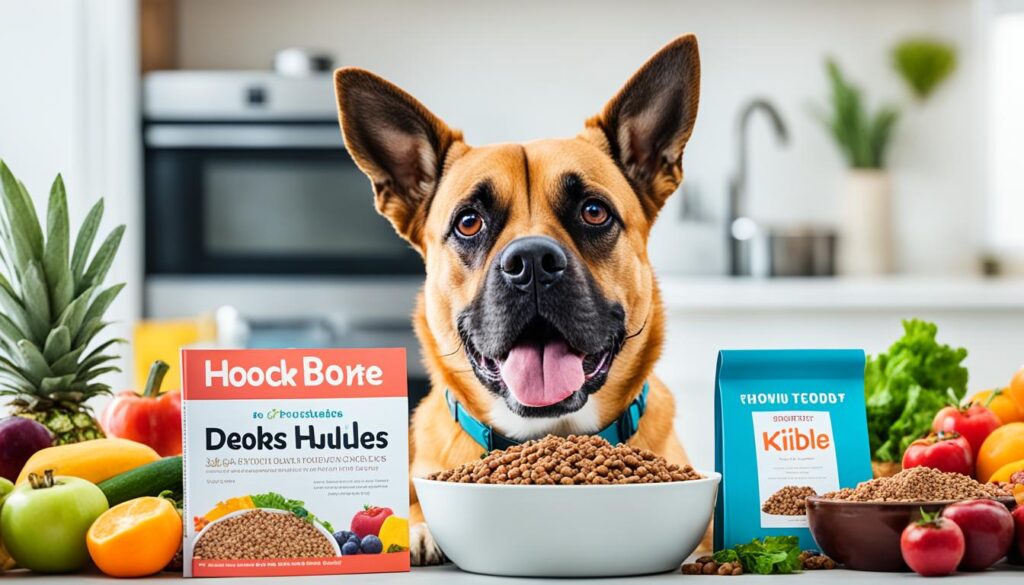
Remember, these recipes are just a starting point, and it’s essential to consult with your veterinarian to ensure that they are suitable for your dog’s specific needs. Tailoring your dog’s diet to their individual requirements can go a long way in promoting their overall health and happiness.
Feeding Your Dog Homemade Food
When it comes to providing the best nutrition for your furry friend, feeding your dog homemade food can be a great option. Not only does it give you control over the ingredients, but it also ensures that your dog is getting a balanced diet tailored to their specific needs. In this section, we will discuss the practical aspects of feeding your dog homemade food, including the recommended daily food portions and how to adjust the amount of food based on your dog’s size, age, and activity level.
Recommended Daily Food Portions
Feeding your dog the right amount of food is crucial for maintaining their overall health and well-being. The recommended daily food portions can vary depending on factors such as breed, weight, and activity level. As a general guideline, veterinarians suggest feeding your dog 2-3% of their body weight per day. For example, if your dog weighs 20 pounds, they would need to consume around 6-9 ounces of food daily.
It’s important to note that this is just a starting point, and you may need to adjust the portions based on your dog’s individual needs. Monitoring your dog’s weight and body condition is crucial in determining if you are feeding them the right amount. If they are gaining weight, you may need to reduce the portions, while if they are losing weight, you may need to increase the portions.
Adjusting the Amount of Food
While the recommended daily food portions provide a general guideline, it’s essential to consider your dog’s specific requirements. Factors such as size, age, and activity level can all influence the amount of food your dog needs.
For example, larger breeds may require more food compared to smaller breeds, while puppies and highly active dogs may need additional calories to support their growth and energy levels. On the other hand, senior dogs or less active dogs may need fewer calories to prevent weight gain.
It’s best to consult with your veterinarian to determine the appropriate portion size for your dog. They can provide personalized recommendations based on your dog’s specific needs.
“Feeding your dog homemade food allows you to customize their diet to meet their individual needs. By considering factors such as age, size, and activity level, you can ensure that your dog is getting the right amount of food to keep them happy and healthy.”
Keep in mind that in addition to the daily food portions, you should also include treats and snacks in your dog’s diet. However, it’s important to limit the amount of treats to ensure they don’t disrupt the balance of their overall nutrition.
Now that we have covered the practical aspects of feeding your dog homemade food, let’s take a look at some delicious homemade dog food recipes that you can prepare for your furry companion in the next section.
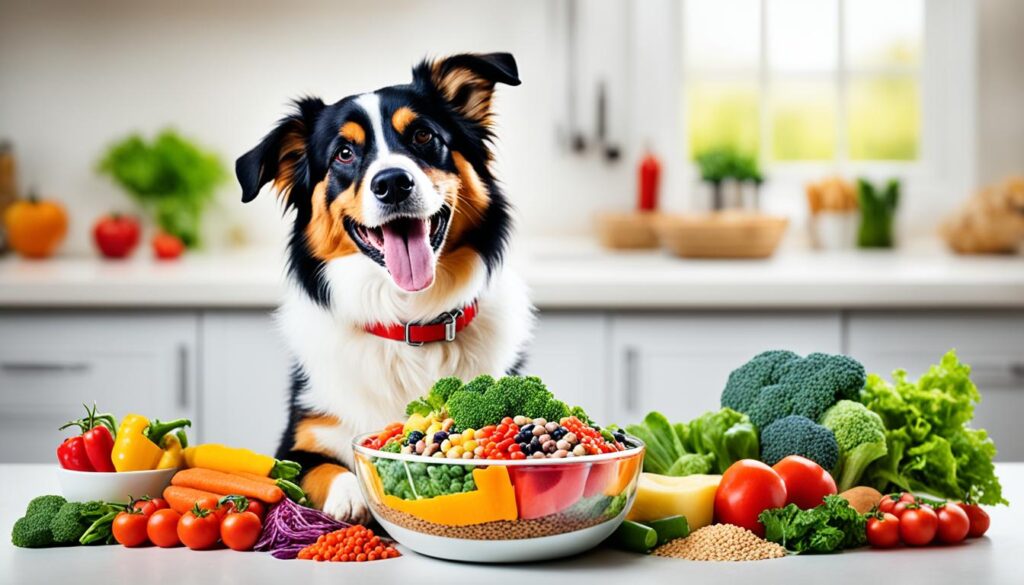
Safety Measures and Storage Tips
Ensuring the freshness and quality of the homemade dog food is essential for your furry friend’s health. Follow these safety measures and storage tips to keep their meals safe and nutritious.
Storing Food in the Fridge
When storing prepared homemade dog food in the fridge, make sure to use airtight containers to prevent spoilage and odors. Label each container with the date to keep track of freshness. Food in the fridge should be consumed within three to five days to maintain optimal quality.
Freezing Dog Food for Longer Shelf Life
For extended storage, consider freezing portions of dog food. Divide the prepared homemade dog food into individual servings and place them in freezer-safe containers or zip-top bags. Remember to remove excess air to minimize freezer burn. Frozen dog food can be safely stored for up to three months.
Serving Appropriate Temperatures
When feeding your dog, it’s important to serve their food at an appropriate temperature. Avoid serving food that is too hot, as it can cause burns or discomfort. On the other hand, do not serve food directly from the fridge, as hot food can be difficult for dogs to consume and digest. Allow refrigerated food to reach room temperature or warm it slightly before serving.
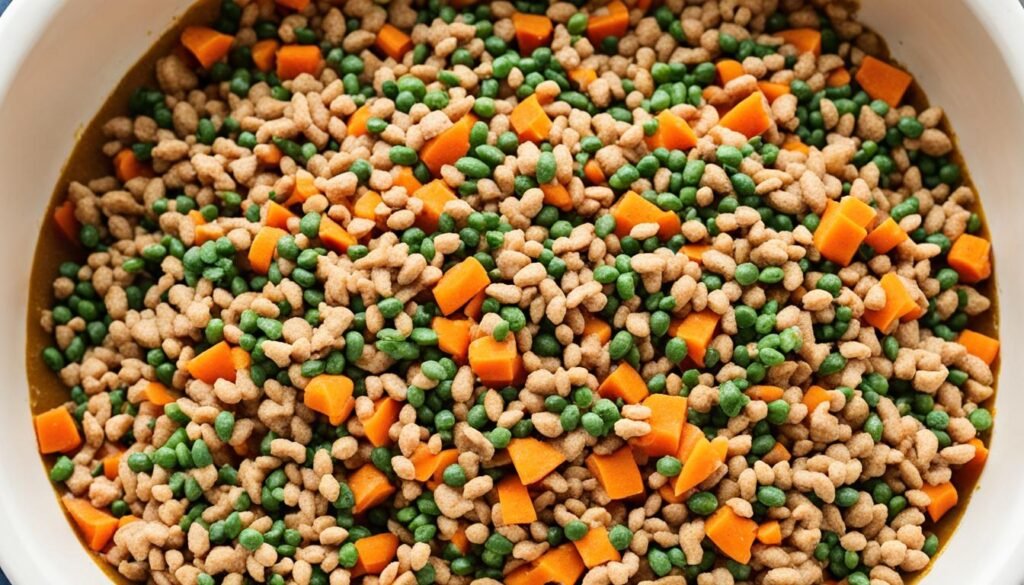
Additional Safety Tips
Here are a few more safety measures to keep in mind:
- Always wash your hands and all utensils thoroughly before and after handling homemade dog food to prevent cross-contamination.
- Ensure that the ingredients used in your homemade dog food recipes are fresh and suitable for canine consumption.
- Regularly inspect the storage containers for any signs of wear or damage, replacing them if necessary.
- If you’re unsure about the safety or quality of any ingredient or prepared dog food, consult with your veterinarian.
By following these safety measures and storage tips, you can maintain the freshness and nutritional value of the prepared homemade dog food, ensuring that your loyal companion receives the best quality meals.
Benefits of Homemade Dog Food
When it comes to nourishing your beloved furry friend, a healthy dog diet is of utmost importance. Homemade dog food offers a variety of benefits that can contribute to your dog’s overall well-being.
One of the key advantages of homemade dog food is that it allows you to have full control over the ingredients. By using natural dog food, you can ensure that your dog is receiving wholesome, nutritious meals without any additives or artificial flavors. This eliminates the risk of feeding your dog processed food that may contain harmful ingredients.
Also Read:- 10 Effortless Methods To Reduce Your Spending On Dog Food
Another benefit is the ability to tailor the meals to address specific health issues your dog may have. With homemade dog food, you have the flexibility to select ingredients that promote optimal health for your furry friend. Whether it’s incorporating nutrient-rich proteins, vitamins, or minerals, you can create nutritious dog meals that cater to your dog’s unique needs.
Preparing homemade dog food also allows you to introduce variety into your dog’s diet. By using different recipes and ingredients, you can provide a diverse range of flavors and textures that will keep your dog excited about mealtime. This can be particularly beneficial for dogs that are picky eaters or have specific dietary preferences.
“Feeding your dog homemade dog food can promote a healthy dog diet, providing natural and nutritious meals that can enhance their overall well-being.”
— Dr. Samantha Collins, Veterinary Nutritionist
Furthermore, homemade dog food gives you the opportunity to establish a stronger bond with your furry companion. By investing time and effort into preparing meals for your dog, you demonstrate love and care. This shared experience can strengthen the bond between you and your pet, enriching your relationship.
To visualize the benefits of homemade dog food, take a look at the table below:
| Nutritional Benefits | Advantages of Homemade Dog Food |
|---|---|
| 1. Healthy dog diet | Providing natural and nutritious meals |
| 2. Addressing specific health issues | Tailoring recipes to meet individual needs |
| 3. Varied diet | Introducing different flavors and textures |
| 4. Bonding experience | Sharing love and care through meal preparation |
By incorporating homemade dog food into your furry friend’s diet, you can ensure their nutritional needs are met while providing them with delicious and wholesome meals. It’s a win-win situation that promotes a healthy and thriving dog!
Conclusion
Homemade meals for your furry friend are a great way to show love and care while providing a nutritionally balanced diet. By choosing to start your dog on a feed your dog homemade journey, you can ensure that they enjoy the benefits of homemade dog meals every day.
Not only do homemade meals allow you to control the ingredients, but they also give you the opportunity to customize your dog’s nutrition to meet their specific needs. From dogs with sensitivities to picky eaters, there’s a homemade dog meal recipe for everyone.
Remember, feeding your dog homemade meals is more than just providing them with nutritious food. It’s a way to bond with your canine companion, making mealtime an enjoyable experience for both of you. So, take the first step today and start your dog on a feed your dog homemade journey to a healthier and happier life!
FAQs
Q: Can I make my own dog food at home?
A: Yes, you can make DIY homemade dog food for your furry friend using wholesome creations to ensure they have a healthy and balanced diet.
Q: Why do dogs love homemade food?
A: Dogs love homemade food because it is often made with fresh ingredients and lacks artificial additives that can be found in commercial pet foods.
Q: How can I ensure my dog gets the right nutrition from homemade food?
A: You can ensure your dog gets the right nutrition from homemade food by consulting with a veterinarian or pet nutritionist to create recipes that meet their dietary needs.
Q: How do I prepare a batch of homemade dog food?
A: To prepare a batch of homemade dog food, follow a recipe that includes protein sources, vegetables, and grains suitable for your dog’s health and taste preferences.
Q: Is homemade dog food better than commercial pet food?
A: Homemade dog food can be beneficial as it allows you to control the quality of ingredients and tailor the recipes to suit your dog’s specific dietary requirements.
Q: Can I feed my dog human-grade food?
A: It is possible to feed your dog human-grade food, but it is essential to ensure that the ingredients are safe and suitable for canine consumption.
Q: How much homemade food should I give my dog each day?
A: The amount of homemade food to give your dog each day depends on their size, age, activity level, and specific nutritional needs. Consult with a professional to determine the right portion sizes.
Q: What are some benefits of preparing food for my dogs at home?
A: Some benefits of preparing food for your dogs at home include knowing exactly what ingredients they are consuming, controlling portion sizes, and tailoring the recipes to their tastes.
